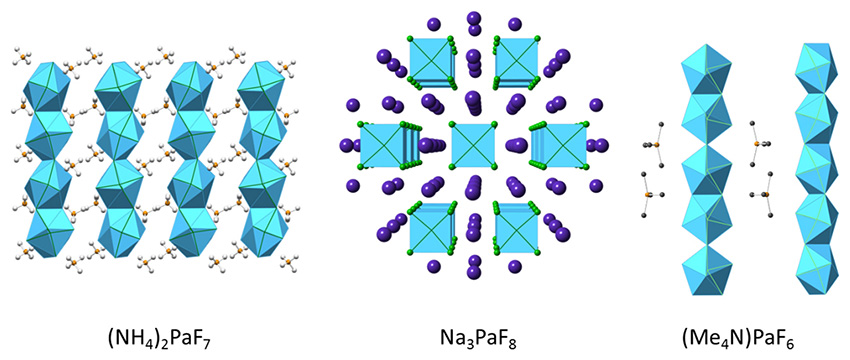At an Elemental Crossroad: Investigating the Chemistry of Protactinium
Studies of protactinium aim to understand its chemistry and its unique electronic properties in the actinide elements.

The Science
The chemistry of protactinium, among the rarest of the naturally occurring elements, reveals unusual chemical behavior and properties making it a unique member of the actinide series of the periodic table of the elements, which include the more well-known heavy elements uranium and plutonium.
The Impact
Protactinium (Pa) sits at the chemical intersection of two major elemental groups; it is not truly an actinide yet not quite a heavy transition metal. This distinctive position makes studying the fundamental chemistry of Pa essential to fully develop a quantitative and predictive understanding of the electronic structure and chemical properties of the entire actinide series.
Summary
Protactinium (Pa), the element between thorium and uranium is the first actinide to possess an electron in its valence f electronic-orbital. Unlike the transition metals such as iron whose chemistry is defined by its d electronic orbitals, or carbon s- and p- orbitals, the f- electronic orbitals are the defining characteristic of the actinides as well as the rare-earth elements. This is critical because the relative energies of the orbitals that participate in a chemical bond, along with their shapes and symmetries, directly affect the observed structure, reactivity and physical properties of a molecule. Importantly, the energies of the outermost f-orbitals, which define the chemistry of the actinide elements, and the outermost d-orbitals that drive the chemistry of the heavy transition metals, cross in energy at protactinium. Pa, though formally part of the actinide series, chemically behaves somewhat like both a transition metal and an actinide. To better understand its exceptionally complex chemistry, scientists at Argonne National Laboratory synthesized a series of Pa-fluoride complexes to demonstrate a variety of coordination environments around the ion. They discovered significant structure and symmetry diversity among the complexes suggesting there is still much to be revealed by studying Pa and its chemical relationship to the other early actinide elements.
Contact
Richard E. Wilson
Argonne National Laboratory
rewilson@anl.gov
Funding
DOE Office of Science, Office of Basic Energy Sciences, Early Career Research Program
DOE Office of Science, Office of Basic Energy Sciences, Division of Chemical Sciences, Geosciences and Biosciences Division, Heavy Element Chemistry Program
Publications
S. M. De Sio, R. E. Wilson, “Structural and Spectroscopic Studies of Fluoroprotactinates” Inorganic Chemistry, 53 (3) 1750–1755(2014). [DOI: 10.1021/ic402877a]
R. E. Wilson, “Retrieval and Purification of an aged 231Pa source from its decay daughters.” Radiochimica Acta (2014). [DOI: 10.1515/ract-2013-2169]
R. E. Wilson, “In Your Element: Peculiar Protactinium.” Nature Chemistry, 4 (7) 586 (2012). [DOI: 10.1038/nchem.1389]
Related Links
“Chemists Rekindle Protactinium Studies.” Chemical and Engineering News.
Highlight Categories
Performer: DOE Laboratory



